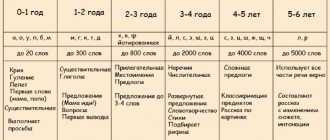A child from one to three years old must learn many things, including speech. Speech development in children is an important aspect of education. It is necessary that a child acquires language skills at the right time because it is important for his holistic development. Speech helps to improve mental activity, broadens the horizons of children, has a positive effect on the psychological component of the child, and regulates his behavior. Therefore, it is important to know how to develop the speech of preschool children. After all, it is during this period that the skill of oral communication is formed.
If speech is well developed, it is easier for the baby and adults to communicate, they understand each other faster, there are no awkward moments in which the mother cannot understand what her baby is saying.
Some adults believe that speech develops on its own and that no effort is needed to help create this skill. But that's not true. Parents should talk to the baby from birth and develop his speech.
It is also important to create conditions with your child in which he can practice his communication skills. If you do not develop your child’s speech, he may start speaking very late. There is also a risk of deviation in complex development. Therefore, parents should know how to develop speech in their child.
Stages of speech development
- Preparatory, or passive. It begins when the child is born and ends when he is 1 year old. At this time, the baby reacts to communication, understands where the sound is coming from, and is ready to play.
- Pre-school, or autonomous. Starts when your son or daughter turns one and ends at age 3. The first sounds and words are not yet entirely clear, but the baby is already trying to form phrases. At this time, vocabulary accumulates. The child understands words and uses them.
- Preschool or active. While a child is preparing for school, his speech is actively developing, and the number of people with whom he communicates increases. The baby can already speak coherently, clearly and comprehensively. Speech becomes a means of understanding the world around us.
- School. The most important, responsible and serious period of speech development. By the age of 18, a child learns the basic rules of grammar, punctuation, and spelling. At this time, it is no longer oral speech that develops, but written speech. The student begins to master literary speech. In addition, he develops a certain slang associated with his age and the company in which he is located.
Spelling
Words in Russian are not always written the way they are pronounced and heard. But the rules of pronunciation are instilled in a child long before he begins to write - and therefore he often strives to write a word the way he pronounces it.
It follows from this that the more a child’s pronunciation differs from the literary one, the more difficult it is usually for him to master spelling. The assimilation of spelling rules of writing is also hampered by individual shortcomings in the child’s pronunciation - nasality, tongue-tiedness, poor articulation.
One of the most important means of helping in mastering the rules of spelling is for the child to pronounce first out loud, and then to himself, clearly, syllable-by-syllable, of the words he writes. It is especially necessary to pronounce those words that the child constantly writes incorrectly.
How to develop oral speech in a child at home?
Features of a child’s speech development depend on his age. A baby can express his mood already in the first week of life, including verbally. Therefore, it is important not to miss this moment and start talking with your son or daughter from the first days. Of course, this does not mean that in six months your baby will be able to quote Pushkin, but there will be a cumulative effect from constant practice.
There are several ways to quickly develop speech in a child. And they all depend on what age the baby is now.
- From birth to 6 months.
All mothers and fathers should have a good habit of talking to the baby all the time and commenting on his actions. For example: “Our Mashenka woke up. Now she and I will get dressed, eat and go for a walk.” For other people, this looks a little strange, but by constantly listening to someone else's speech, the baby gets used to it and begins to repeat sounds and words. The main thing is that you speak the words in the correct intonation, with the correct emphasis, clearly and clearly. There is no need for any “lisping”, otherwise the baby will hear the words in the wrong form.
Parents need to learn short rhymes and songs. By singing them to your baby, the latter will develop speech, a sense of rhythm and hearing. It will be great if reciting rhymes and singing songs occurs during regular procedures: washing, feeding, dressing, walking. Each lesson has its own song. Subsequently, the child will understand from the song what he will do now.
- From six months to a year.
If your baby makes some sounds, be sure to respond to them with words or phrases. Then you will have some kind of dialogue. Use educational games that simultaneously develop speech, fine motor skills and coordination.
Introduce your child to animals. Show him a drawing or picture, tell him the name of the animal, describe it, and then make the sound that the animal makes and ask your son or daughter to repeat it. For example: “This is a cow. She has four legs, horns and a tail. The cow gives milk and says “Moo!” Be sure to show your child the cow from time to time and repeat the sounds it makes.
- From one to 2 years.
Starting from 15 months, the baby’s vocabulary should move from a passive state to an active one. That is, the baby must begin to name things, movements, designation of circumstances. At this moment, it is necessary to continue studying and not stop there.
After a year, it is worth introducing your child to children's educational books, which contain colorful pictures and interesting stories. Read them to your baby and look at the images with him. Tell him objects, colors, characteristics. Try to discuss with him what you saw and read. Read in different voices and intonations as the story requires. This will interest your son or daughter even more. Do this not just once, but regularly, otherwise there will be no benefit.
- From two to three years.
At this age, the baby’s speech develops in three directions:
- The stock of words and concepts increases.
- The child tries to construct complex phrases (“The cat is eating”, “the car is driving”).
- Speech becomes clearer (the sound “r” begins to be pronounced, hissing and whistling sounds disappear).
During this period, the child begins to recognize the world around him, everything becomes interesting to him, he plays “why”. The parents’ task is not to deny him, citing many things to do, but to be patient and answer every question. “Why does the sun shine?”, “Why is the sky blue?”, “Why does the plane fly and not fall?” It is necessary to answer, avoiding complex words and terms. The child must understand what you are explaining to him.
Memo for parents: “How to develop a child’s speech at home”
Development and improvement of speech sound culture:
On the recommendation of teachers, conduct special game exercises with your child to develop and improve the sound culture of speech as an integral part of preparing the child for subsequent literacy training.
To develop phonemic awareness, train your child to identify the first sound in his name, in the names of those around him, in the name of his favorite toy, and then in determining the sequence of sounds in these words; divide words into syllables and determine their sequence.
Monitor the correct stress when pronouncing words by playing games like “So and Wrong”: the adult pronounces words or phrases, combining the correct and incorrect use of stress, and the child listens and corrects the adult, pronouncing the word (phrase) with the correct stress.
Strengthen the pronunciation side of speech with the help of pure tongue twisters and tongue twisters.
Development of the lexical side of speech:
Tell and show your child a lot, read educational literature, take him on excursions, and make observations. Look carefully at individual objects and items. In this case, it is advisable to take into account the cognitive preferences (interests) of your child.
Tell your child about your relatives (where they live, who they work for, what wonderful people they are, how they relate to the child); about your work or study, about the people who surround you.
Continue the family tradition of talking about your day every day. (What made you happy today? What made you sad? What surprised you? Etc.) Discuss and plan all joint activities with your child.
On the recommendation of teachers, conduct special speech games in order to enrich and improve the lexical side of the child’s speech.
Formation of grammatical
speech structure:
Exercise your children in using verbs correctly. Play speech games with your child like “Who can do what?” on the selection of verbs (for example: “What can a cat do and like to do? Run, sleep, lap, play, meow,” etc.); “Change the word” to the ability to use and form verbs with the prefixes u-, at-, you-, for-, pere-, under-, etc.
In everyday communication with your child, create speech situations that allow the child to coordinate nouns with numerals.
Monitor how the child uses complex forms of plural nouns in the genitive case.
Encourage your child’s desire to use complex types of sentences (complex and complex sentences) in speech.
In play situations, practice your child in making simple and common sentences.
Development of coherent speech in children
Teach your child to be polite and tactful when participating in dialogue with adults and children. During conversations with your child, demonstrate a culture of dialogue. Show an example of how to conduct a dialogue at the table, at a party, when talking on the phone.
Strengthen the skills acquired in kindergarten in composing coherent monologue statements through: composing stories based on family photographs; stories based on a series of pictures; fairy tale retellings; compilation of elementary descriptions.
Encourage your child to try to write fairy tales and stories. Make sure you follow the rules for composing coherent statements. Play out children's compositions using theatrical means.
Starting from the age of five, children move to senior preschool age. This is the period of the most harmonious
the child’s condition: many functions have already been formed, and at the same time, the crisis of seven years has not yet arrived, when the body begins to rebuild.
This is the best time of childhood!
Children of this age are inquisitive, independent and active. In this regard, their speech capabilities increase significantly, their vocabulary expands, and their speech becomes grammatically formatted and meaningful.
In order for a child to master oral speech in a timely and high-quality manner, it is necessary that he use it as often as possible, coming into contact with adults and peers.
“TO LEARN TO SPEAK, YOU MUST SPEAK!”
MUNICIPAL AUTONOMOUS EDUCATIONAL INSTITUTION
"SECONDARY EDUCATIONAL SCHOOL No. 2" - (MAOU Secondary School No. 2)
Memo for parents
“How to develop a child’s speech at home”
Prepared by: Vinokurova L.N.
Tobolsk 2021
Ways to develop speech in a child
- "Mom doesn't understand." If the baby can already name objects, but does not do this, parents can pretend that they do not understand what the child wants from them, forcing him to say: “What can I give you? Teddy bear? A spoon? Kitten? The baby usually easily buys into such a technique and names the item he needs.
- “What will we choose?” In everyday situations, ask your child his wishes. “Will you go for a walk in a yellow or blue blouse?” “Do you want fish or salad for dinner?” Thus, the child will learn to formulate his thoughts and present them in verbal form. In addition, such an exercise will lay the foundation for independence and responsibility.
From 6 to 12 months
The second half of the year is characterized by the emergence of the most important means of communication - speech. There is a development of skills that were formed in the previous six months of life. Hearing becomes more refined and more selective. The child begins to establish a connection between word and object, between action and word; learns to distinguish sounds that are similar to each other. Understands nouns, and then verbs.
Vocal reactions that were formed up to this point develop. At first these are loud sounds, rich and emotional, then hooting - short sounds, like “ahu”. Then babble begins: a combination of vowels and consonants that is similar to meaningful human speech. We hear “ba-ba-ba”, “ta-ta-ta”, “ma-ma-ma”, but the child does not attach any meaning to these sounds. That is, “ma-ma-ma” does not necessarily refer to mom. A word appears when a child puts meaning into a combination of sounds.
Babbling first appears and is most clearly expressed in situations of communication with an adult. It is very important for parents, when observing the development of a child in the first year of life, to pay attention to whether the baby babbles and how it develops. The absence of babbling is a sign that the child’s hearing needs to be checked by a specialist.
The babbling continues throughout the second half of the year. For a child, this is a special form of independent activity, a means of communication and a way of expressing an emotional state. At the same time, the pronounced sounds are based on imitation and self-imitation - the child listens very carefully to what he comes up with, tries out different combinations of sounds.
Imitation is the basis for speech development, so it is very important for an infant to have adults nearby who communicate with him and with each other. If they are close, the babbling becomes more intense.
The child continues to pay attention to the articulation of the adult and repeats after him the movements of the lips and tongue, as well as new sounds that he hears from him. In this case, delayed imitation occurs: the baby hears some sounds, carefully watches the adult, and after some time pronounces them himself.
At 6-7 months, primary understanding of words develops. At the request of an adult, the child finds an object that lies in the same place and turns his head towards this object. For example, we can ask: “Where is the doll?” and the baby will turn his head towards the doll.
"Where?" - this is the first question to which a child reacts and which he understands
The connection between word and object at this age is very unstable. The child perceives the object in the context of the here and now. In the place where the object is currently located. If an object changes its location, the infant may not indicate it.
At 8-9 months, the child can already find an object, even if it always lies in different places. To the question “Where is the doll?” the baby will crawl towards the doll, and he can go to another room, knowing that it is there, and point to it.
The child develops a constant perception of objects. He understands that if an object is covered with some kind of scarf, then it is simply not visible. If moved to another place, then it retains its functions and remains the same.
At the same age, the child begins to perform simple movements at the request of an adult - sits down, stands up. The parent says: “Show me your hands,” and the child begins to clap his hands. “Wave goodbye,” and waves his hand.
Soon the baby will understand basic instructions: “Give mom a spoon,” “Put it down,” “Take the ball.”
You may find this course for parents of children aged 0 to 1 year useful. We will help you create a developmental environment at home with your own hands and learn to understand the needs of your baby at an early age.
At 10-11 months, the child selects objects from two or more according to the verbal instructions of an adult. A ball and a cube can lie in front of him, and when the mother asks him to take the cube, the baby can handle it.
Understanding the relationship between an object and a name is the most important achievement in the development of an infant's speech. In the future, this gives the child the opportunity to interact with objects in their absence and develop an idea of objects in the form of images.
By the end of the year, the child understands the names of most of his toys. He knows the names of objects with which he interacts - for example, dishes - and understands the verbs of the simplest actions: drink, walk, lie down, sleep.
The so-called babbling triads, or babbling speech, appear. It is always addressed to an adult: the child looks into his eyes, gestures, smiles. Babbling is directed at an adult and at the expectation of a reaction from him. In fact, this is a way of communicating with adults.
Outwardly, the child accurately reproduces the situation of verbal communication, although there is no content in this babble. At the same time, the adult easily understands what the baby wants to tell him. It is babbling that precedes the appearance of active speech.
Also, by the end of the first year of life, many children acquire separate words that have their own constant meaning and sound. For example, “nyay-nyay” (= “give-give”), “af-af” (= dog), “am-am” (= eat). These are the so-called autonomous words.
Features of speech formation
One of the most important conditions for the development of a child’s personality is the complete and timely acquisition of speech skills. As a rule, these skills begin to develop in childhood and preschool age. Ideally, at the end of the first year of life, the baby should be able to pronounce simple words, and by the age of 3-4 years, his vocabulary should consist of approximately 1000 words.
In theory, at the age of 4 years, a child can already retell a simple fairy tale, describe his actions, and analyze the actions of his parents. However, a different situation is increasingly encountered in practice. That is why pediatricians, child psychologists and speech therapists try to blur clear boundaries, since each child is unique and the process of speech development can proceed in its own way.
For the early development of a child’s speech, it is necessary to create ideal conditions in which the baby:
• physically develops in accordance with age;
• does not suffer from neurological diseases;
• actively communicates with others;
• willingly repeats words spoken by relatives and friends;
• speaks out his desires;
• listens to adult speech;
• tries to pronounce words correctly.
In reality, creating such conditions can be problematic. The reason for this may be mental retardation, previous illnesses, neurological pathologies, or an unfavorable social environment.
In some cases, we can talk about delayed speech development if the child:
• repeats heard words or phrases without much desire;
• does not respond or deliberately clenches his teeth when asked to repeat a spoken word or phrase;
• independently solves everyday problems, deliberately without turning to adults for help;
• pronounces non-existent words;
• does not pay attention to the fact that his speech is incomprehensible to others;
• speaks worse than his peers.
It is believed that girls pronounce their first word before boys. However, they can master phrase speech later, and with age they try to speak in an adult manner. In boys, on the contrary, their grammatical structure is first formed. At the same time, they master adult speech later, replacing it with “their” vocabulary.









